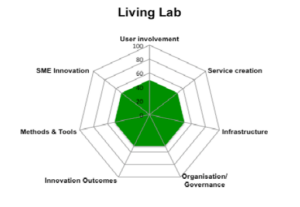Self Assessment Toolbox
Living Labs (LL) are user-centred, open-innovation ecosystems often operating in a territorial context, integrating concurrent research and innovation processes within a public-private-people partnership.
Co-creation and experimental testing of products in real-life cases are key aspects of living labs and helping companies access new markets.
LLs belongs to the ”family” of test and experimental platforms.
LLs need self-assessment like any other organisation which intends to develop and expand.
A toolbox (SAT) has been developed for monitoring of the progress of Living Labs.
The process of self-assessment consists of the assessment itself, the feedback and possible guidelines to improve the performance.
The toolbox is based on a Spider-web diagram (Schumacher 2014): a radar is used to capture the various stages of a Living Lab.

Spider-web diagram includes the analyses of the following stages:
user involvement; service creation; infrastructure; organisation and governance; innovation outcome; SME innovation.
The scale is defined as follows: 5- always, 4- mostly, 3- half of the time, 2-rarely, 1-not relevant.
The idea of the SAT is to evaluate progress and development over regular time, for example once a year. The SAT was tested twice with 13 LLs. Significant improvements in LL operation in one year were reported.
The self-assessment toolbox can be found here: https://scanbalt.org/livinglabs/toolbox/
The full report of the development and testing the SAT can be found HERE

